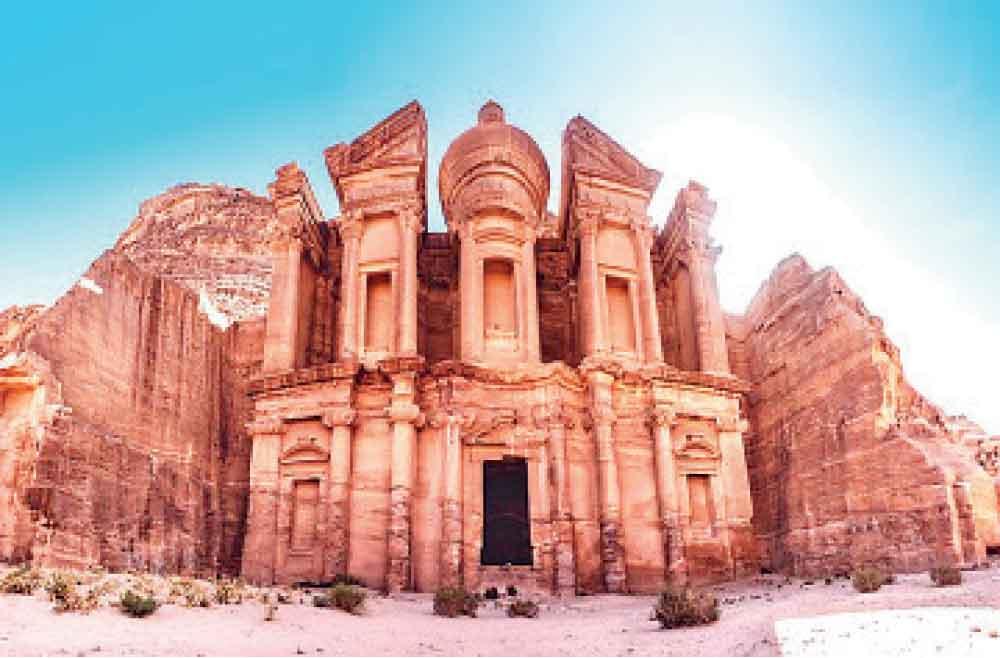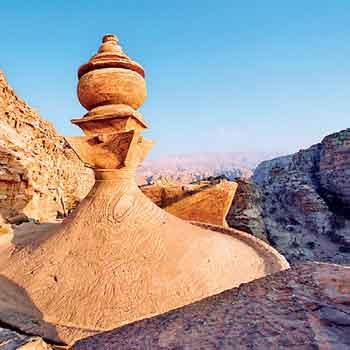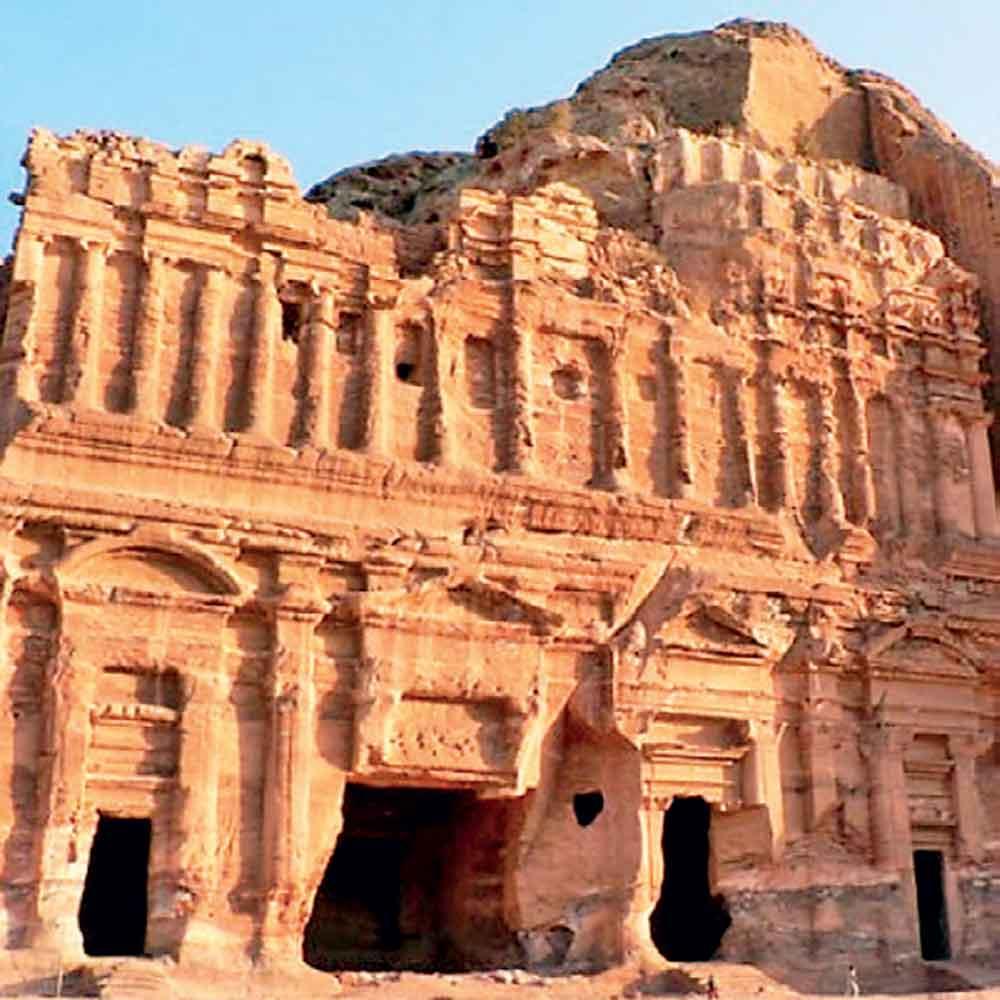
 Deep in the heart of the Jordanian desert lies a place of mystery, grandeur, and ancient wonder Petra, the legendary “Rose City.”Once a thriving capital of the Nabataean Kingdom, Petra is now one of the most iconic archaeological sites in the world. Hidden behind towering rock cliffs, this ancient city remained unknown to the modern world for centuries, earning it the nickname "The Lost City." Today, it stands as one of the New Seven Wonders of the World, captivating travelers with its breathtaking rock-cut architecture, fascinating history, and unparalleled beauty.
Deep in the heart of the Jordanian desert lies a place of mystery, grandeur, and ancient wonder Petra, the legendary “Rose City.”Once a thriving capital of the Nabataean Kingdom, Petra is now one of the most iconic archaeological sites in the world. Hidden behind towering rock cliffs, this ancient city remained unknown to the modern world for centuries, earning it the nickname "The Lost City." Today, it stands as one of the New Seven Wonders of the World, captivating travelers with its breathtaking rock-cut architecture, fascinating history, and unparalleled beauty.
Petra is unlike any other city. Instead of being built, it was carved directly into the red sandstone cliffs over 2,000 years ago. The Nabataeans, an ancient Arab civilization, transformed this hidden desert valley into a bustling trade hub, connecting the East and West. They mastered the art of rock-cut architecture and developed an advanced water management system, allowing their city to flourish despite its arid surroundings.
Despite centuries of study, much of Petra’s history remains unknown.
Today, as you walk through Petra’s narrow Siq; a natural gorge that serves as the city's dramatic entranceyou feel as though you are stepping back in time. The anticipation builds with every step until, suddenly, the path opens up, revealing Petra’s most famous monument:
The Al-Khazneh, or The Treasury, is Petra’s most iconic landmark. This magnificent structure, standing nearly 40 meters tall, was carved into the rose-colored rock face with incredible precision. Despite its name, the Treasury was not a bank or a treasury, but rather a royal tomb, possibly for a Nabataean king.
Visiting Petra during the day is incredible, but Petra by Night is pure magic
 Legend has it that the urn at the top of the Treasury contains hidden treasures but attempts to retrieve them have failed. Bullet holes from treasure hunters are still visible, adding to the mystery surrounding this awe-inspiring monument.
Legend has it that the urn at the top of the Treasury contains hidden treasures but attempts to retrieve them have failed. Bullet holes from treasure hunters are still visible, adding to the mystery surrounding this awe-inspiring monument.
While the Treasury is Petra’s most famous site, it is just the beginning. The city stretches over 60 square kilometers, with countless tombs, temples, and hidden pathways waiting to be explored.
If you think the Treasury is impressive, wait until you see Ad-Deir, The Monastery. This massive structure is even larger than the Treasury, standing at nearly 50 meters wide and 45 meters tall. To reach it, you must climb 800 rock-cut steps, but the breathtaking view from the top is worth every step.
The Royal Tombs, carved into the cliffs, are believed to be the burial sites of Petra’s elite. These grand tombs, with their intricate carvings and massive facades, reflect the city’s past glory.
Walking through Petra, you’ll come across the remains of a grand street lined with columns, once the heart of the city's commercial and social life. Nearby, the ruins of the Great Templestand as a testament to the Nabataeans’ architectural skill.
For those seeking a spiritual and scenic experience, the High Place of Sacrificeoffers breathtaking panoramic views over Petra. This sacred site was used for religious rituals and sacrifices, and reaching it requires a steep but rewarding hike.
The Siq is more than just a passageway leading to Petra; it is an attraction in itself. The 1.2-kilometer-long gorge is flanked by towering cliffs, and along the way, you will notice ancient carvings, water channels, and niches that once held statues of deities. Walking through the Siq is an unforgettable experience, especially in the early morning or late afternoon when the sunlight creates dramatic shadows and illuminates the red rock walls.
Petra is more than just a historical site; it’s an experience that transports you to another world.
Visiting Petra during the day is incredible, but Petra by Nightis pure magic. Imagine walking through the Siq, guided only by the glow of thousands of candles, until you reach the Treasury. Here, under a sky filled with stars, traditional Bedouin music fills the air, creating an unforgettable atmosphere. This special experience offers a glimpse into the mysticism and allure of this ancient city.
The Mystery and Legacy of Petra
Despite centuries of study, much of Petra’s history remains unknown. How did the Nabataeans, a nomadic people, build such a sophisticated city? What caused its decline and abandonment? Archaeologists continue to uncover new secrets buried beneath the desert sands, keeping the mystery of Petra alive.
Petra’s strategic location along ancient trade routes made it a wealthy city, but its success was also its downfall. Over time, shifting trade routes and natural disasters led to the city’s gradual abandonment. By the 14th century, Petra had fallen into obscurity until its rediscovery by Swiss explorer Johann Ludwig Burckhardt in 1812.

How to Visit Petra: Travel Tips
- The best time to visit Petra is during the spring (March to May) and autumn (September to November) when temperatures are mild. Summers can be scorching, while winters can be chilly, especially at night.
- Petra is located in southern Jordan, about a 3-hour drive from Amman, the capital. Most visitors arrive by car, bus, or as part of a guided tour. The nearest airport is Queen Alia International Airport in Amman.
- There are several accommodations available in the nearby town of Wadi Musa, ranging from budget hostels to luxury hotels. Staying close to the Petra entrance allows for an early start, helping you avoid crowds.
Other Activities Nearby
- Little Petra: A smaller but equally fascinating archaeological site located just outside Petra.
- Wadi Rum: Known as the “Valley of the Moon,” this desert landscape is perfect for camping, jeep tours, and stargazing.
- The Dead Sea: Just a few hours away, it offers a unique floating experience in the world’s saltiest body of water.











